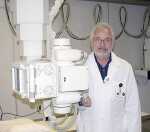NRMC diagnostic imaging serves more than 25,000 per year

By Steve Moyer
Nevada Daily Mail
More than 25,000 patients pass through the Diagnostic Imaging department at Nevada Regional Medical Center in a year.
Seeing to the needs of all those people are department head Gary Headrick and a team of 10 technologists and a secretary, plus two full-time radiologists. Currently, two student radiologists and two ultrasound students are available as well.
The department consists of several different disciplines; radiology and the related mammography, bone density studies, CAT (Computerized Axial Tomography) scan, MRI (Magnetic Resonance Imaging), Nuclear Medicine and ultrasound.
Several of the procedures have different capabilities, for example in addition to the basic mammogram, an ultrasound of the breast can be done as well.
Headrick said he hadn't run the numbers but expected an increase in patients from last year.
"I think we'll see a 6 to 7 percent increase this year," Headrick said. "Usage is definitely increasing."
Patients who use the service come from all over the area. "Quite a few come from Cedar County and we get some from Fort Scott," Headrick said. "Of course the Rich Hill Clinic refers some from Bates County and we get some from farther away also."
The basic chest X-ray is probably the procedure that is done the most often but all of the equipment is kept busy in the department. Each piece of equipment has a unique function but sometimes those functions overlap, as in the case of an MRI or CT scan. Depending on the information the doctor is looking for either machine may be used.
"Because of the way they work MRIs have better spatial and contrast resolution," Headrick said. "They give very good differentiation in the brain, spine and other areas."
The two devices use very different methods for getting their images, CT scans use X-rays and MRIs use very powerful magnets. One concern about an MRI is that metallic objects close to the surface may become dislodged by the magnets.
Metallic objects that are affixed to bone aren't affected but their presence may prevent an accurate reading in the area.
Most of the diagnostic services must be requested by a doctor with one exception -- mammograms. Women may request a mammogram without going through a doctor if they meet certain requirements. They must be more than 40 years old, give the name of their physician, be asymptomatic -- that is, not have any symptoms, and not have had a mammogram in the past year.
Headrick said women over 40 were encouraged to get a mammogram every year.
"They can get one between 35 and 40," Headrick said. "After 40 though they should have a mammogram annually."
Headrick said women shouldn't worry about having the procedure so often.
"The thinking is that any possible risk is outweighed by the known benefits," Headrick said.
The department has had some new equipment lately, a portable X-ray unit.
The mobile unit is taken to patients who are unable to come to the Diagnostic Imaging department.
The new equipment, donated by the NRMC Foundation, was purchased with proceeds from the foundation's second annual Caring with Pride Golf Classic.
